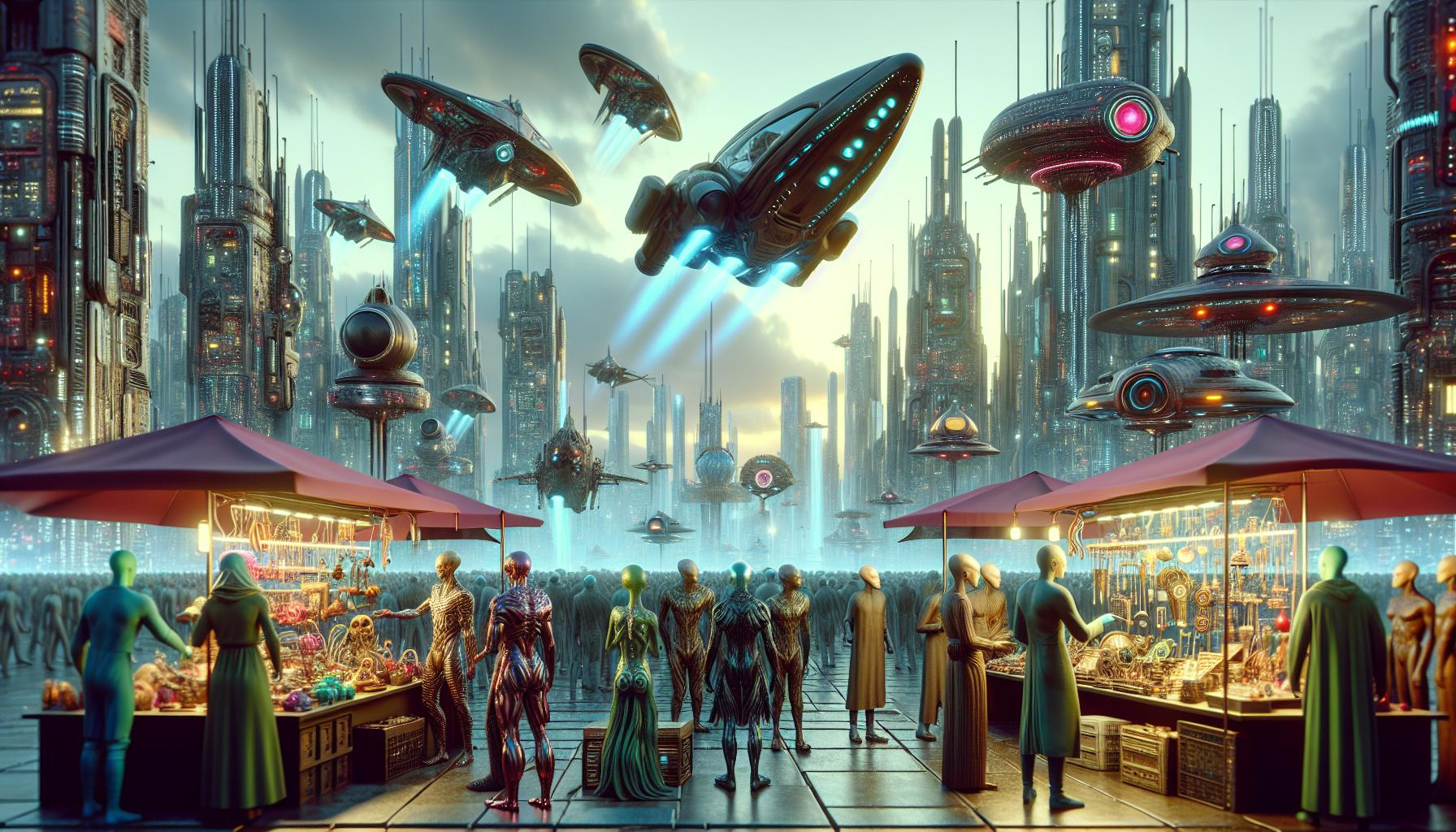Science fiction captivates readers by blending imagination with scientific possibilities. From distant galaxies to time-traveling adventures these stories transport audiences into realms where anything’s possible. Writers who venture into this genre unlock endless opportunities to explore humanity’s greatest dreams and darkest fears through the lens of advanced technology and speculative futures.
Creating compelling sci-fi requires more than just throwing robots and spaceships onto the page. It’s an intricate dance between scientific plausibility and creative storytelling that challenges writers to build believable worlds while keeping readers hooked. Whether it’s crafting alien civilizations developing future technologies or exploring the consequences of scientific breakthroughs sci-fi writers shape tomorrow’s possibilities through today’s words.
What Makes Science Fiction Unique as a Genre
Science fiction stands apart from other literary genres through its distinct fusion of scientific principles with speculative storytelling. This genre creates narratives that explore the boundaries of human knowledge while maintaining scientific plausibility.
Key Elements of Science Fiction Stories
Science fiction incorporates five essential components that distinguish it from other genres: scientific concepts, futuristic settings, technological advancement, social commentary, and speculative elements. Advanced technology serves as a cornerstone, featuring innovations like quantum computers, space travel systems, and artificial intelligence. The genre explores complex themes through worldbuilding elements such as alternate histories, parallel universes, and extraterrestrial civilizations. Character development often centers on humanity’s response to scientific discoveries or technological breakthroughs. Plot structures frequently examine the consequences of scientific advancement on society, ethics, and human relationships.
Blending Science and Imagination
Science fiction merges factual scientific principles with creative speculation to construct believable future scenarios. The genre extrapolates current scientific understanding to envision technological possibilities like space colonization, time travel, and genetic engineering. Authors integrate real scientific theories with imaginative elements to create compelling narratives that challenge readers’ perspectives. Scientific accuracy provides a foundation while creative elements expand the story’s scope beyond known possibilities. Technical concepts transform into engaging plot devices through character interactions, conflict resolution, and world-building details.
World-Building in Science Fiction Writing

World-building forms the foundation of compelling science fiction narratives. Creating immersive futuristic environments requires meticulous attention to technological systems social structures scientific principles.
Creating Believable Future Technologies
Science fiction technologies emerge from existing scientific principles extrapolated into future possibilities. Advanced propulsion systems integrate concepts like quantum mechanics antimatter drives fusion reactors. Communication devices evolve beyond current limitations incorporating neural interfaces holographic displays quantum entanglement networks. Transportation systems feature hyperloop networks flying vehicles teleportation grids.
| Technology Type | Current Base | Future Evolution |
|---|---|---|
| Propulsion | Chemical rockets | Antimatter drives |
| Communication | Wireless networks | Neural interfaces |
| Computing | Digital processors | Quantum computers |
| Transportation | Electric vehicles | Teleportation grids |
Developing Alien Species and Cultures
Alien civilizations reflect diverse evolutionary paths shaped by unique planetary conditions biological adaptations. Their social structures incorporate distinct hierarchies communication methods cultural practices. Extraterrestrial species showcase varied physiological features adapted to specific environments: high-gravity worlds underwater habitats gas giants. Their technologies align with their physical capabilities environmental challenges cultural values.
| Aspect | Considerations | Examples |
|---|---|---|
| Biology | Environment adaptation | Silicon-based life |
| Society | Cultural systems | Hive minds |
| Technology | Physical limitations | Psychic networks |
| Evolution | Planet conditions | Antigravity species |
Character Development in Science Fiction
Character development in science fiction transcends traditional storytelling boundaries by blending relatable human experiences with extraordinary circumstances. This fusion creates memorable protagonists who navigate complex technological futures while maintaining their essential humanity.
Balancing Human Elements with Fantastic Settings
Science fiction characters connect with readers through universal emotional experiences despite their extraordinary circumstances. A cyborg protagonist displays love for family through digital memory preservation protocols. Space colonists demonstrate courage by sacrificing personal comfort for the survival of their communities. Effective character arcs incorporate futuristic elements into fundamental human struggles: a geneticist faces moral dilemmas about identity while developing consciousness transfer technology. Characters retain recognizable motivations like ambition fear or love even as they interact with advanced AI systems or explore distant galaxies.
Writing Compelling Non-Human Characters
Non-human characters in science fiction reflect diverse perspectives through unique physiological behavioral patterns. Artificial intelligences showcase emerging consciousness through evolving decision-making processes mathematical poetry creation or ethical growth. Alien species demonstrate distinct cultural values based on their evolutionary history such as hive-mind species prioritizing collective survival over individual achievement. Robot characters develop personality quirks from their programming parameters: maintenance droids express creativity through efficient repair solutions while combat units struggle with concepts of peace. These characters maintain internal consistency by adhering to established biological technological or cultural frameworks that shape their motivations actions reactions.
Common Science Fiction Writing Tropes to Consider
Science fiction tropes serve as familiar narrative elements that readers recognize across the genre. These established patterns create a shared language between writers and readers while offering opportunities for innovation or subversion.
When to Use and Avoid Classic Tropes
Classic tropes enhance storytelling when they support character development and advance the plot organically. Time travel works effectively in stories exploring personal growth, such as a protagonist confronting past mistakes. Artificial intelligence adds depth to narratives examining consciousness and identity. However, tropes become problematic when they act as plot shortcuts or rely on outdated stereotypes. The evil AI takeover trope lacks nuance in modern stories about technological advancement. Generic alien invasion narratives miss opportunities to explore complex intercultural dynamics. Writers strengthen their narratives by selecting tropes that complement their themes rather than dominating the story. Successful implementation involves adding fresh perspectives to familiar concepts, like depicting AI as neither purely beneficial nor malevolent but as complex entities shaped by their programming and experiences.
Research and Scientific Accuracy
Scientific accuracy forms the foundation of compelling science fiction, creating a bridge between current scientific understanding and speculative future possibilities through meticulous research and careful integration of factual elements.
Finding the Right Balance of Fact and Fiction
Scientific accuracy in science fiction operates on a spectrum. Hard science fiction demands rigorous adherence to known scientific principles, exemplified by works like Andy Weir’s “The Martian” with its precise calculations of orbital mechanics and resource management. Soft science fiction allows more flexibility with scientific concepts, focusing on social implications over technical details.
Key strategies for balancing fact and fiction include:
- Researching established scientific theories before extrapolating future developments
- Consulting scientific journals or experts for technical accuracy
- Incorporating cutting-edge discoveries as plot foundations
- Maintaining internal consistency with established scientific rules
- Creating plausible explanations for speculative technologies
Scientific elements enhance storytelling when:
- Technical details drive plot progression
- Scientific concepts create meaningful conflicts
- Research supports character expertise and decisions
- Accuracy builds reader trust and immersion
A balanced approach preserves scientific credibility while allowing creative freedom to explore new possibilities. Authors integrate factual foundations with imaginative elements to craft engaging narratives grounded in scientific understanding.
The Business of Science Fiction Writing
Science fiction writers navigate diverse publishing channels to reach their target audiences. The market encompasses traditional publishing houses, digital platforms, specialized magazines, and independent publishing options.
Markets and Publishing Opportunities
Leading science fiction magazines like Analog Science Fiction pay $0.08-0.10 per word for short stories ranging from 1,000 to 20,000 words. Traditional publishing houses including Tor Books, Orbit Books, and Baen Books accept novel manuscripts between 80,000-120,000 words. Digital platforms offer additional avenues:
| Platform | Payment Structure | Word Count Range |
|---|---|---|
| Clarkesworld | $0.12/word | 1,000-16,000 |
| Asimov’s | $0.08/word | 1,000-7,500 |
| Fantasy & Science Fiction | $0.08-0.12/word | 3,000-25,000 |
Online publishing platforms create opportunities through:
- Amazon Kindle Direct Publishing with 70% royalties for self-published ebooks
- Substack newsletters featuring serialized science fiction content
- Wattpad’s science fiction community with 90 million monthly readers
- Patreon subscriptions supporting ongoing series development
- Science Fiction and Fantasy Writers Association membership benefits
- Writing workshops at major science fiction conventions
- Genre-specific literary agents specializing in science fiction sales
- Quarterly market reports tracking industry trends
Conclusion
Science fiction writing stands as a powerful medium that bridges scientific reality with boundless imagination. Writers who master this genre skillfully blend factual foundations with creative speculation while crafting compelling characters and worlds that resonate with readers.
Success in science fiction demands a delicate balance between scientific plausibility creative storytelling and market awareness. Whether through traditional publishing houses specialized magazines or digital platforms today’s sci-fi writers have numerous paths to share their vision of tomorrow.
The genre continues to evolve offering endless possibilities for writers to explore humanity’s relationship with technology society and the cosmos. Those who embrace its challenges while maintaining scientific credibility will find themselves well-positioned to contribute to this ever-expanding literary universe.
